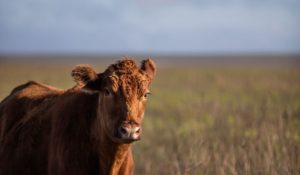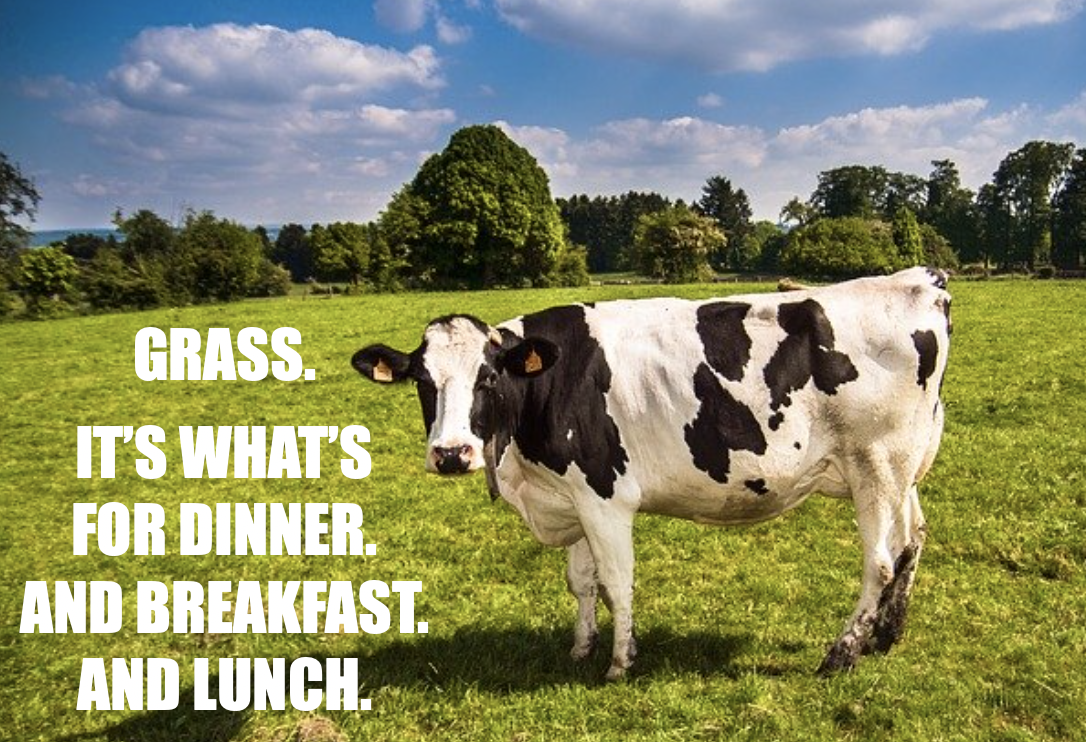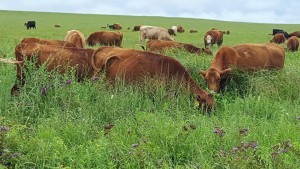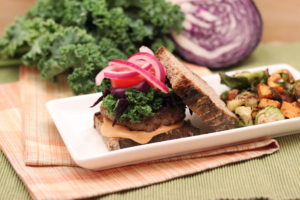In response to our coaching tip last week about “Should you only eat organic?”, an amazing member of our Eat REAL America community requested insights on topics like grass-fed beef, organic milk and free range chicken, and whether it is worth buying organic varieties of canned goods, such as broth, beans, maple syrup and more.
These are all great topics and we wanted to shed some light on one of these…
…grass-fed beef.
We have all probably heard it and wondered…is grass-fed beef really better?
If so, why? And, is all grass-fed beef the same? We wanted to provide more insight on this topic, so we went straight to the experts!
 We are blessed to have a great friendship with a couple of the most innovative and passionate grass-fed beef producers in the country. Linda and Keith Long own Graze the Prairie, located in a small town 45 miles east of Wichita, KS. Linda and Keith lease 2,000 acres and graze a closed herd of cattle, which means they only breed their existing cattle. We have come to admire Linda and Keith very much for all they do to make healthy, grass-fed beef available to their loyal customers.
We are blessed to have a great friendship with a couple of the most innovative and passionate grass-fed beef producers in the country. Linda and Keith Long own Graze the Prairie, located in a small town 45 miles east of Wichita, KS. Linda and Keith lease 2,000 acres and graze a closed herd of cattle, which means they only breed their existing cattle. We have come to admire Linda and Keith very much for all they do to make healthy, grass-fed beef available to their loyal customers.
We are thrilled to share some of their expert insights!
What does “grass-fed” mean?
If cattle are “grass-fed and grass-finished,” it means the cattle have only eaten a variety of grasses their entire life. However, in the industry, many cattle are called “grass-fed,” even though they are fed grain on the pasture or switched to a diet of grains during their last several weeks – or months – of life. This is a significant distinction because the nutrient profile of the meat is changed even from the very first feeding of grain.
CAUTION! It is “buyer beware” when it comes to buying grass-fed beef. To reap all the benefits, it’s important to buy meat that is grass-fed AND grass-finished. Just because a label says “grass-fed” doesn’t necessarily mean it is grass-fed and grass-finished. Also, a grass-fed label doesn’t tell you anything about other practices such as the use of antibiotics or hormone supplements, environmental practices or whether the animals are confined or out roaming the pastures. When buying grass-fed beef, it is important to ask questions and, ideally, to get to know your producer and their practices.
Is grass-fed beef really nutritionally better? How does it compare nutritionally to conventional beef?
You may be surprised, but yes, as shown in studies like this one, there is a huge difference in the nutrient profile.
100% grass-fed and finished beef has the perfect balance of Omega-3 and Omega-6 fatty acids. Grass-fed beef has a 2:1 ratio of Omega-6 to Omega-3 whereas conventional beef can have a ratio of up to 6:1 (or even higher). If your ratio of Omega-6 to Omega-3 is too high, it can contribute to adverse health consequences. For more information on Omega-6 vs. Omega-3, see our coaching tip Oils…They Are Not Created Equal.
Grass-fed beef also contains CLA, or conjugated linoleic acid, which is a natural trans-fat that is good for our bodies. These are different from the “bad” trans-fats that harm our bodies. Unfortunately, conventional beef contains very little CLA. Grass-fed beef also contains a higher percentage of stearic acid, which is a type of saturated fat that does not raise blood cholesterol levels.
Grass-fed beef is an antioxidant heaven! It is loaded with higher levels of vitamins and minerals than conventional beef. This is simply because of all the vitamins and minerals contained in the soil and the grass the cattle are consuming. They have higher levels of Vitamins A & E, beta-carotene and other antioxidants, which provide a number of benefits including protecting against damage that occurs during the cooking process.
How do the lives of grass-fed cattle compare to conventional cattle?
 At Graze the Prairie, our cattle are born on the pasture and the only life they know is on the pasture. They lead a relatively stress-free life, grazing on pasture and soaking up the sun. We don’t use antibiotics unless it is absolutely necessary to treat an animal. And, any animal treated with antibiotics is removed from the herd and never sold as grass fed beef through Graze the Prairie. Our cattle are typically harvested at 24-30 months, which allows more flavor to develop in the meat.
At Graze the Prairie, our cattle are born on the pasture and the only life they know is on the pasture. They lead a relatively stress-free life, grazing on pasture and soaking up the sun. We don’t use antibiotics unless it is absolutely necessary to treat an animal. And, any animal treated with antibiotics is removed from the herd and never sold as grass fed beef through Graze the Prairie. Our cattle are typically harvested at 24-30 months, which allows more flavor to develop in the meat.
Conventional cattle live much different lives. They are often confined, fed a diet of mainly corn and are harvested at about 14 to 18 months. Because of the unhealthy conditions they are in, they are often given antibiotics to try to prevent illness and are often given hormone supplements to speed up the growth process. Just like humans, animals are simply not meant to consume that much corn…you are basically killing the animals with their diet, and then slaughtering them before they would die from natural causes.
So, there is a dramatic difference in the lives of these animals!
What about flavor? How does grass-fed compare to conventional beef?
Many say the flavor of grass-fed beef is richer and more intense. The flavor is, of course, influenced by what the cattle are eating. You may even notice a difference in an animal harvested in the winter compared to one harvested at the end of summer. This is simply because the dormant grasses in the winter will provide a different flavor than the vibrant grasses during the growing season.
It’s also important to realize the fat in grass-fed beef may have a yellow tint to it. This is an indicator of how nutrient-rich your meat is. The yellow tint means the meat has a higher content of Vitamin A, beta-carotene and other nutrients.
If you have ever wondered why restaurants don’t serve more grass-fed beef, it is often because they think their customers prefer the consistency of conventional beef. Even though conventional is not as healthy and doesn’t have the same intense flavor, many U.S. restaurants don’t want to deal with the perception of a different flavor or color. In other parts of the world, grass-fed beef is much more prevalent in restaurants.
How is grass-fed beef better for the environment?
 At Graze the Prairie, we manage our pastures using rotational grazing, where we move the cattle frequently among different pastures. This not only feeds the cows, but also allows the pastures to naturally regenerate themselves. We do not use pesticides, insecticides or “-cides” of any kind. Some producers might use chemicals to treat pesky horn flies but, by moving the cattle frequently, we have found that we can manage the flies naturally.
At Graze the Prairie, we manage our pastures using rotational grazing, where we move the cattle frequently among different pastures. This not only feeds the cows, but also allows the pastures to naturally regenerate themselves. We do not use pesticides, insecticides or “-cides” of any kind. Some producers might use chemicals to treat pesky horn flies but, by moving the cattle frequently, we have found that we can manage the flies naturally.
What does “organic” mean in the world of grass-fed beef?
Just like produce, a producer can get an organic certification by having a 3rd party inspect the farm to confirm the practices, including the grass the cattle are consuming, are organic. Keep in mind, organic certification is a very expensive process. Some producers follow organic practices even though they don’t go through the process to become certified. Organic doesn’t mean grass-fed…it can mean that the cattle is fed organic grain. Graze The Prairie is Certified Grass-Fed and Animal Welfare Approved through A Greener World. We are one of very few certified producers in Kansas.
What about price?
 The price of grass-fed beef can be slightly higher than conventional beef. Because it is typically produced on a smaller scale by smaller producers, we just don’t have the same economy-of-scale as the large commercial producers. We try to price our product as competitively as we can and our customers find that the nutrition, taste and other benefits outweigh the slightly higher cost. You can also save money (20% or more) by purchasing a larger quantity, such as a quarter or a side of beef.
The price of grass-fed beef can be slightly higher than conventional beef. Because it is typically produced on a smaller scale by smaller producers, we just don’t have the same economy-of-scale as the large commercial producers. We try to price our product as competitively as we can and our customers find that the nutrition, taste and other benefits outweigh the slightly higher cost. You can also save money (20% or more) by purchasing a larger quantity, such as a quarter or a side of beef.
Remember, it’s about quality not quantity — you can balance the increased cost by decreasing your portion sizes, allowing your meat to add flavor and texture and compliment your plate filled with fiber rich in-season vegetables!
Do you cook grass-fed beef differently?
Cooking grass-fed beef is not dramatically different, but because it is lower in fat, there are a few things to know to produce the best results. When cooking steak, you want your grill or skillet hot, hot, hot! (Cast iron works great). You want to sear the surface of both sides of the steak to seal in the flavor. Cook the steak 3-4 minutes per side — don’t overcook it! Then, let the meat rest for 5 minutes to let the juices absorb back into the meat. When roasting, it’s also useful to sear the outside first to seal in the juices and flavor.
When cooking ground beef, you can add a tablespoon of oil (or butter), to offset the lower fat content. The fat content of ground beef in the summer will have approximately 85/15 fat content and in the winter it’s likely to be more like 95/5. While many people may look for the lowest fat ratio possible, remember that the fat in grass-fed beef is good for you…that’s where many of the nutrients are found.
What else would you like people to know?
 We encourage people to get to know their local producers and find one they like. Ask them questions about how they feed and raise their cattle. Make sure the animals are 100% grass-fed AND grass-finished.
We encourage people to get to know their local producers and find one they like. Ask them questions about how they feed and raise their cattle. Make sure the animals are 100% grass-fed AND grass-finished.
Grass-fed beef is completely worth it, especially considering the nutrition and taste. Plus, the holistic management practices are so much better for the environment, the community and the animals. The economic, ecologic, social and health benefits that come from raising and consuming grass-fed beef are extraordinary!
At Eat REAL America, we are firm believers in grass-fed and grass-finished beef! We love knowing our producers and how they are feeding and raising their animals. And, the nutrition benefits must be real…Keith is very humble and won’t admit this, but he is a crazy-good runner and has the Kansas state record for his age group in several distances including the 5k, 10 mile, 15k and half-marathon! Coincidence? Probably not!
Thank you, Linda and Keith, for your time and very helpful insights!
Here are just a few ideas to enjoy great-tasting grass-fed beef:
Grilled Steak Panzanella Salad
Steak & Roasted Vegetable Medley
Slow Cooker Italian Beef Sandwiches
Strip Steak Over Shaved Brussels Sprouts

Steak Salad with Roasted Sweet Potatoes
 LEARN MORE ABOUT THE NAPKIN!
LEARN MORE ABOUT THE NAPKIN!



This is WONDERFUL information–thank you so much! During the pandemic, I signed up with Butcher Box to have meat delivered to our door. Their meats are 100% grass-fed, grass-finished beef, free-range, organic chicken, heritage-breed pork, and wild-caught seafood. We love the quality and service.
That sounds fantastic – so proud of both of you for investing in quality meat! And having it delivered to your door…well, it doesn’t get much better than that!
Really interesting — thank you for the information.
Thank YOU! Glad this was helpful!
Thank you for sharing this information. I will start looking out for Grass fed and grass finished beef.